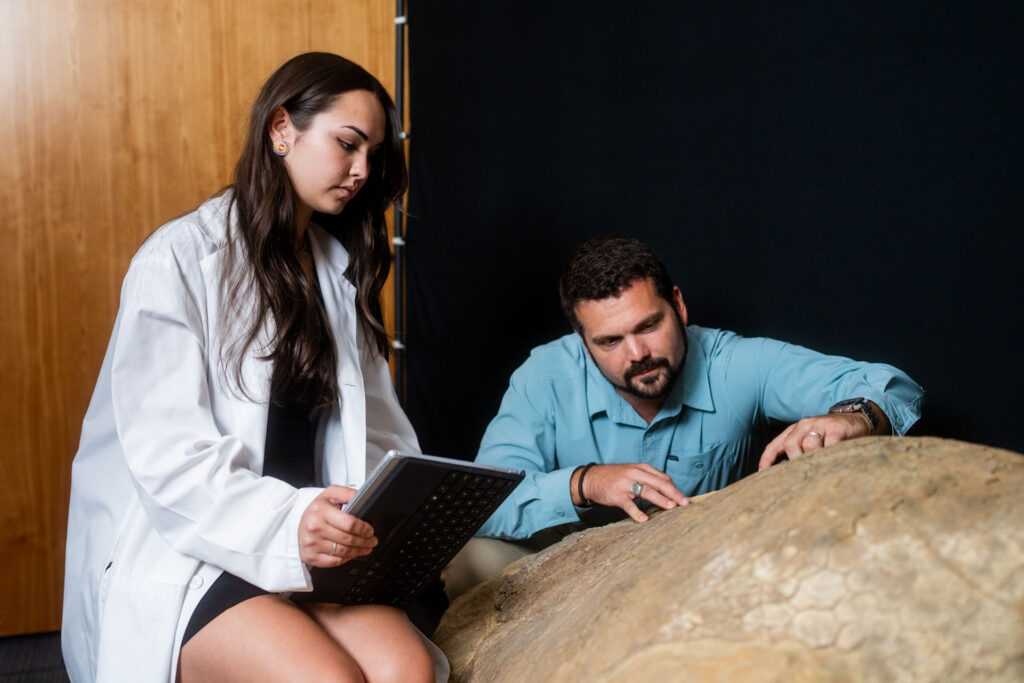Ueloca colemanorum: A Fossil That Carries the Voice of the Poarch Creek Indians
Share this:
The Poarch Creek Indians are celebrating a historic moment as their language and heritage are etched into the scientific record through the naming of a newly discovered fossil; a fossil that carries deep cultural and historical significance for the Tribe.

A Discovery Rooted in Ancestral Land
The fossilized shell of a recently discovered 32-million-year-old leatherback sea turtle was recently made by an Alabama family while fishing along a river in south Alabama. A rare, nearly complete specimen, the turtle shell, which is roughly 4 feet long and 3 feet across, represents a new genus and species of leatherback sea turtle and is one of the most complete fossils of its kind found anywhere in the world.
The fossil itself is extraordinary. And the location of the fossil, now named Ueloca colemanorum, makes it especially meaningful to the Poarch Creek Indians, who see in it both a connection to their past and an opportunity to carry their voice into the future.
A team of researchers led by Dr. Drew Gentry, Paleontologist with the Learning Campus at Gulf State Park, identified and studied the fossil, bringing scientific recognition to the find. Dr. Gentry’s team worked closely with Kimberly Gregson, Poarch Creek Tribal Member, student, and active member of Dr. Gentry’s research team, along with employees of the Poarch Creek Indians Cultural Department, to ensure the fossil’s name honored both science and heritage. Gregson spent countless hours working on the fossil and reviewing the scientific literature, and was a co-author on the formal scientific paper published on September 12. She not only assisted in the naming of the turtle but was also an integral part of the research team that studied it. Her experience researching Ueloca is what led her to pursue a degree in Fish, Wildlife, and Conservation Biology at Colorado State University.
Scientific names are usually based on biology. Dr. Gentry originally approached the Poarch Creek Indians about naming the fossil, due to it being discovered on their ancestral homeland and Gregson being a Tribal Member as well as a member of the research team. Working with scientists and the Poarch Creek Indian Language Department to incorporate cultural aspects into the name meant the process had to be looked at in a totally different way. The chosen name blends the Muscogee (Creek) word ueloca, meaning “water turtle,” with a Latinized acknowledgment of the Coleman family.
Gregson described the naming process as unlike anything she had imagined. “Being part of naming a new species is something I never thought I would get to do, and as a Tribal Member of the Poarch Creek Indians, it was even more meaningful to name the species in my people’s native language. As a Tribal Member, Creek culture has always been a part of my life. This fossil being found on my people’s homeland draws me to a deeper connection to this discovery. It means a lot to me to bring my perspective to represent my Tribe in this project,” said Gregson.
Collaboration Between Science and Culture
For the Poarch Creek Indians, the naming is about more than recognition, it is an act of cultural preservation. The Tribe’s Calvin McGhee Cultural Department guided the naming process, engaging language experts to ensure authenticity and meaning. This marks the first time the Tribe has been directly involved in naming a fossil, and it represents their broader commitment to strengthening culture through education, history, and science.
For Dr. Gentry, the collaboration demonstrates the power of bridging culture and science. “Partnerships like this show how honoring culture and advancing science can go hand in hand,” he said. “Working with Kimberly and the Poarch Creek Indians was vital to ensuring this discovery carries lasting significance.”
The Tribe hopes the naming of Ueloca colemanorum will inspire future opportunities for Native voices to be embedded in discoveries that shape history.
Gregson echoed this sentiment, noting how much language matters to the Tribe’s identity: “Language is so important to the Poarch Creek Indian Tribe because a lot of our history is passed down through storytelling. Since Muscogee is a dying language, we have to incorporate it into our lives as much as possible to keep our culture alive. Since scientific names are permanent, this discovery means that a part of our language and culture will continue on forever.”
The fossil will be displayed at the McWane Science Center in Birmingham, AL, where it will be accessible to the public and serve as both a scientific treasure and a cultural legacy.